Becoming a successful artist is very much like a lottery in which you work for years just to get a ticket. Those who reach the rarefied art world of echoing galleries and champagne receptions typically arrive there after long periods of insecurity and brutal soul-searching (and as a result, often don’t enjoy it). The intermediate world of aspiring artists is crowded, chaotic, and generally ignored, since it’s much easier to take art seriously once somebody else has validated it. Yet in many ways it is more interesting than the art world itself.
The first question that occupies artists is what art to make. This seems basic, but many artists struggle with it perpetually. The sheer scope of media available today, plus the knowledge that there is a potential audience for pretty much anything, is as terrifying as it is liberating.
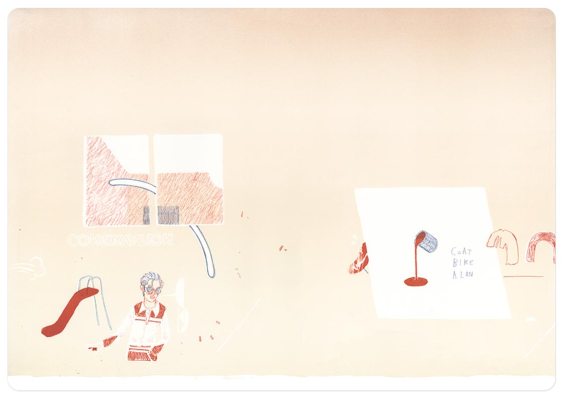
Even we, sometimes, make mistakes (II) (2015), Rob Miles, stone lithograph
This is a problem I’ve been discussing for a while with artist Rob Miles. He has chosen to shelve his interest in computer-generated imagery, claiming that, compared to other artists in this medium, he is ‘like a child playing in the mud’. Instead, he has chosen to concentrate intensively on printmaking, and to explore the possibilities opened up by this singular focus.
‘You need to narrow it down to what is essential about your work’, he says. ‘For me it was drawing, and then print was the most interesting way to do that.’ He wants to master his medium to discover new ways of using it. The layering process of lithography has given him a way to interpret the overlapping visual systems of modern life, drawing inspiration from digital space and the interaction of reality with media and technology.
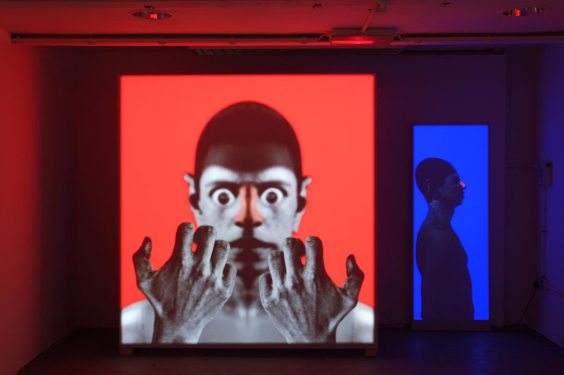
Stigmata (2015), Joe Pearson, video projection
Another young artist, Joe Pearson, makes for an interesting comparison here. When Pearson began at the Slade, he says, ‘I had already boxed myself in as a painter.’ Eventually though, his search for affecting imagery led him to experiment with stop frame animation and digital collage. The resulting video projections, which were my pick of this year’s degree shows, combine the mythical figuration of William Blake with the paranoid intensity of cartoons such as Dragon Ball Z. What is essential about Pearson’s work is his idiosyncratic vision, and this has been brought to life by the discovery of a new medium.
But whether you are honing a craft or experimenting, the underlying factor for all artists is time and resources. A universal concern for art graduates is how they will pay for a studio and materials, not to mention bills, and what time will be left for actually making art.
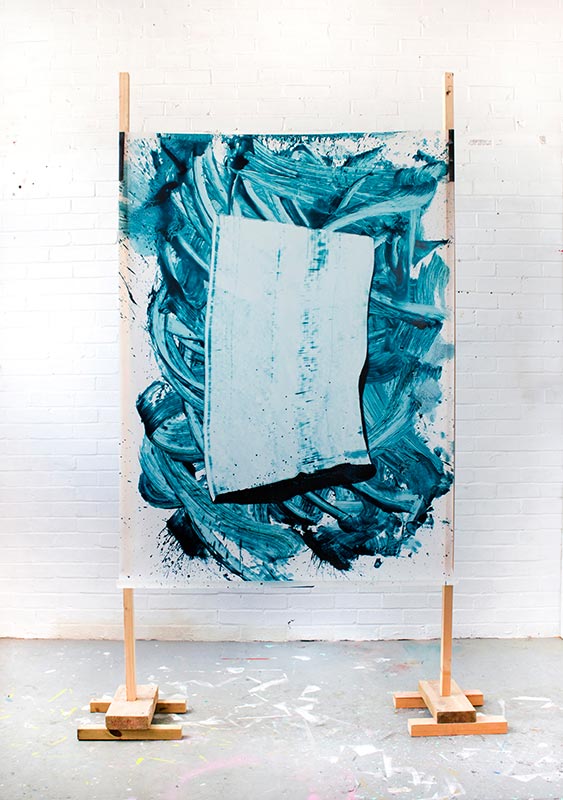
Wipe/Swipe (2014), Hannah Rowan, oil on lighting diffusion paper, wood, gaffer tape
Yet such challenges also bring new opportunities for inspiration. For Hannah Rowan, long periods away from the studio working as a set-builder for commercial film have been transformative. ‘My work is still going on in my head’, she says, ‘so often I’d see lighting equipment rigged-up on set, see it as a kind of free-standing structure, and I’d find it really beautiful.’ She has recently made a fascinating series of works that use the detritus of the film industry as a framework for her gestural abstract painting.
The painting itself is done on lighting diffusion paper – a material used to soften lighting for film – which renders the brush-strokes in a uniquely sensitive way. This is attached to a makeshift support using cable-ties, croc-clips, gaffer tape or clamps, and is finally lit with security lighting. All of these techniques came originally from the need for her work to be collapsible and storable in limited studio space (which canvases are not), but she now values their temporary character.
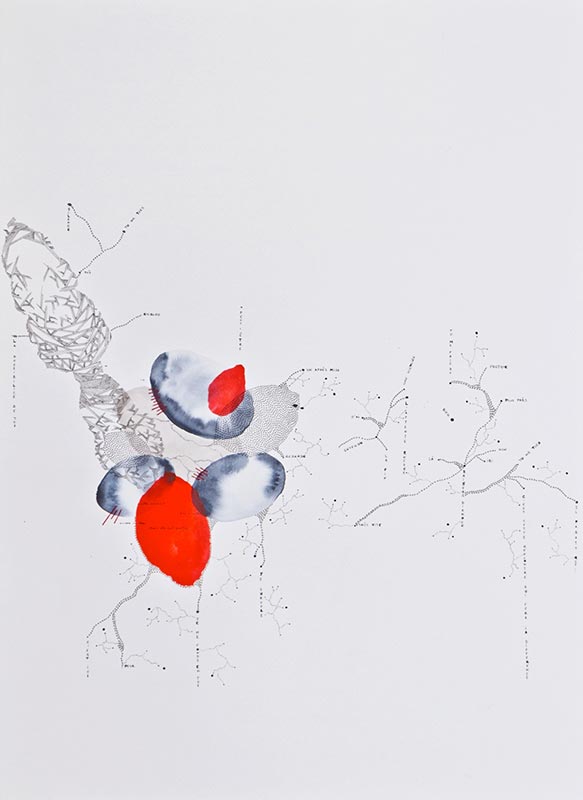
Silent, from the series ‘Loose Notes of Sorrow’ (2015), Alison Bignon, rotting ink, print, watercolour
Young artists are not altogether alone. There are people and organisations dedicated to nurturing talent. One such individual I’ve met recently is gallerist and art dealer Marine Tanguy, an energetic fairy godmother figure who is currently helping seven young artists in their ‘battle of 10 years’ to become established. She aims to get them into respected collections, link them with other institutions and with the global market, find affordable studios and publish coverage of their work.
Tanguy is looking for ‘very strong aesthetics and very strong layers of techniques’, and likes artists ‘who master their techniques for years’. Among these are Scarlett Bowman and Alison Bignon, who have pioneered new ways of working with jesmonite casts and ink drawings respectively. The search for these sorts of innovations seems to be one thing that unites aspiring artists generally. They recognise a world that demands novelty, but do not want to sacrifice integrity in the process. A difficult balance for them, but one that bodes very well for the audience.
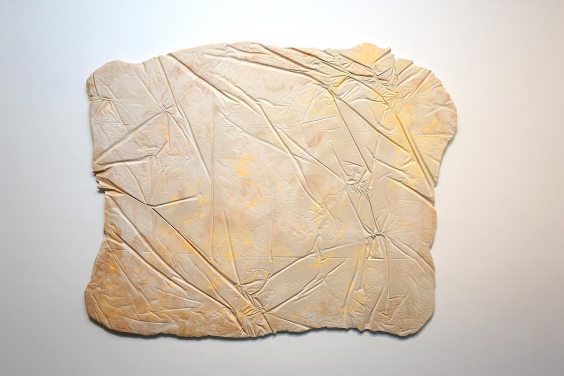
P5, from the series ‘Trashscapes’ (2015), Scarlett Bowman, composite, jesmonite and acrylic
Related Articles
Scouring the art schools: the search for the UK’s best young artists (Justin Hammond)
Mapping the contemporary: Bloomberg New Contemporaries vs. Tomorrow: London (Jack Orlik)

What are the challenges facing young artists today?
Stigmata (2015), Joe Pearson, video projection
Share
Becoming a successful artist is very much like a lottery in which you work for years just to get a ticket. Those who reach the rarefied art world of echoing galleries and champagne receptions typically arrive there after long periods of insecurity and brutal soul-searching (and as a result, often don’t enjoy it). The intermediate world of aspiring artists is crowded, chaotic, and generally ignored, since it’s much easier to take art seriously once somebody else has validated it. Yet in many ways it is more interesting than the art world itself.
The first question that occupies artists is what art to make. This seems basic, but many artists struggle with it perpetually. The sheer scope of media available today, plus the knowledge that there is a potential audience for pretty much anything, is as terrifying as it is liberating.
Even we, sometimes, make mistakes (II) (2015), Rob Miles, stone lithograph
This is a problem I’ve been discussing for a while with artist Rob Miles. He has chosen to shelve his interest in computer-generated imagery, claiming that, compared to other artists in this medium, he is ‘like a child playing in the mud’. Instead, he has chosen to concentrate intensively on printmaking, and to explore the possibilities opened up by this singular focus.
‘You need to narrow it down to what is essential about your work’, he says. ‘For me it was drawing, and then print was the most interesting way to do that.’ He wants to master his medium to discover new ways of using it. The layering process of lithography has given him a way to interpret the overlapping visual systems of modern life, drawing inspiration from digital space and the interaction of reality with media and technology.
Stigmata (2015), Joe Pearson, video projection
Another young artist, Joe Pearson, makes for an interesting comparison here. When Pearson began at the Slade, he says, ‘I had already boxed myself in as a painter.’ Eventually though, his search for affecting imagery led him to experiment with stop frame animation and digital collage. The resulting video projections, which were my pick of this year’s degree shows, combine the mythical figuration of William Blake with the paranoid intensity of cartoons such as Dragon Ball Z. What is essential about Pearson’s work is his idiosyncratic vision, and this has been brought to life by the discovery of a new medium.
But whether you are honing a craft or experimenting, the underlying factor for all artists is time and resources. A universal concern for art graduates is how they will pay for a studio and materials, not to mention bills, and what time will be left for actually making art.
Wipe/Swipe (2014), Hannah Rowan, oil on lighting diffusion paper, wood, gaffer tape
Yet such challenges also bring new opportunities for inspiration. For Hannah Rowan, long periods away from the studio working as a set-builder for commercial film have been transformative. ‘My work is still going on in my head’, she says, ‘so often I’d see lighting equipment rigged-up on set, see it as a kind of free-standing structure, and I’d find it really beautiful.’ She has recently made a fascinating series of works that use the detritus of the film industry as a framework for her gestural abstract painting.
The painting itself is done on lighting diffusion paper – a material used to soften lighting for film – which renders the brush-strokes in a uniquely sensitive way. This is attached to a makeshift support using cable-ties, croc-clips, gaffer tape or clamps, and is finally lit with security lighting. All of these techniques came originally from the need for her work to be collapsible and storable in limited studio space (which canvases are not), but she now values their temporary character.
Silent, from the series ‘Loose Notes of Sorrow’ (2015), Alison Bignon, rotting ink, print, watercolour
Young artists are not altogether alone. There are people and organisations dedicated to nurturing talent. One such individual I’ve met recently is gallerist and art dealer Marine Tanguy, an energetic fairy godmother figure who is currently helping seven young artists in their ‘battle of 10 years’ to become established. She aims to get them into respected collections, link them with other institutions and with the global market, find affordable studios and publish coverage of their work.
Tanguy is looking for ‘very strong aesthetics and very strong layers of techniques’, and likes artists ‘who master their techniques for years’. Among these are Scarlett Bowman and Alison Bignon, who have pioneered new ways of working with jesmonite casts and ink drawings respectively. The search for these sorts of innovations seems to be one thing that unites aspiring artists generally. They recognise a world that demands novelty, but do not want to sacrifice integrity in the process. A difficult balance for them, but one that bodes very well for the audience.
P5, from the series ‘Trashscapes’ (2015), Scarlett Bowman, composite, jesmonite and acrylic
Related Articles
Scouring the art schools: the search for the UK’s best young artists (Justin Hammond)
Mapping the contemporary: Bloomberg New Contemporaries vs. Tomorrow: London (Jack Orlik)
Unlimited access from just $16 every 3 months
Subscribe to get unlimited and exclusive access to the top art stories, interviews and exhibition reviews.
Share
Recommended for you
The Art of Work: Visiting the David Parr House
Is this remarkable house Cambridge’s best kept secret?
England’s history in photographs: highlights from ‘Picturing England’
Fascinating photographs from an extraordinary collection
New scheme to get work by female artists into museums
Valeria Napoleone and the Contemporary Art Society are taking a proactive approach to a protracted issue